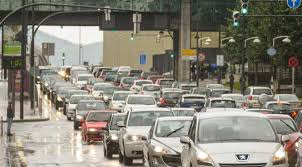Air pollution in the CAV caused 1,270 deaths in 2022, according to the European Environment Agency
- Environmentalists in Action have denounced that there is no improvement plan to deal with pollutants such as NO2 and PM2.5 particles around the world. It has also called for reducing traffic and prioritizing sustainable alternatives in order to improve air quality.

According to a report by the European Environment Agency (EEA), air pollution in CVA caused 1,270 deaths in 2022.
According to the document "The impact of air pollution on human health in Europe", fine particles, nitrogen dioxide (NO2) and ozone air pollution caused 181 premature deaths in Álava in 2022, 323 in Gipuzkoa and 766 in Bizkaia. According to the report, most of the deaths occurred in Bizkaia, accounting for 60 per cent of the total. Bajo Nervión is one of the most affected areas, as it accumulates a significant number of assigned deaths. According to ecologists, a mandatory Improvement Plan has not yet been implemented in this area, although the measurement stations located in it exceeded the limits established for nitrogen dioxide in 2016 and 2017.
In the European Union, the number of deaths from fine particles rose to 239,000, while Ekologistak Martxan estimated 70,000 and 48,000 deaths from evasion zitezkeen.Ozonoak and nitrogen dioxide.
Ekologistak Martxan has denounced that 65% of these deaths are related to PM2.5, which is less than 2.5 microns, and that inspection of this pollutant has not been a priority for the Basque Government. The organization has warned that in some traffic control stations and capitals monitoring had not started until 2020, despite the fact that “the XXI. Since the beginning of the twentieth century, the risks associated with these particles were well known.”
The organisation has also criticised the fact that the requests for the implementation of the PM2.5 Improvement Plan, supported by Ararteko himself, have not received a response from the Basque institutions.
These estimates of the European Agency account for 5-11% of the 24,203 deaths recorded in the CAPV in 2022, with a ratio of 79 to 161 deaths per each hundred thousand inhabitants over 30 years. Bizkaia is one of the most disadvantaged areas, with ratios of 91 and 173, exceeding the Spanish State average.
Faced with this situation, Ekologistak Martxan has urged the Basque Government, the deputies and the Basque municipalities to promote public transport and pedestrian movements in order to join the Sustainable Mobility Act. They have also stressed the need to reduce private vehicle traffic as the main factor affecting air quality.
Energiaren Nazioarteko Agentziak (IEA) astelehenean argitaratutako txostenaren arabera, %2,2 igo da energia eskaria 2024an aurreko urtearekin alderatuta, besteak beste, egiturazko arrazoi hauengatik: beroari aurre egiteko argindar gehiago erabili beharra, industriaren kontsumoa... [+]
Kutsatzaile kimiko toxikoak hauteman dituzte Iratiko oihaneko liken eta goroldioetan. Ikerketan ondorioztatu dute kutsatzaile horietako batzuk inguruko hiriguneetatik iristen direla, beste batzuk nekazaritzan egiten diren erreketetatik, eta, azkenik, beste batzuk duela zenbait... [+]
Lurrak guri zuhaitzak eman, eta guk lurrari egurra. Egungo bizimoldea bideraezina dela ikusita, Suitzako Alderdi Berdearen gazte adarrak galdeketara deitu ditu herritarrak, “garapen” ekonomikoa planetaren mugen gainetik jarri ala ez erabakitzeko. Izan ere, mundu... [+]
Ur kontaminatua ur mineral eta ur natural gisa saltzen aritu dira urte luzeetan Nestlé eta Sources Alma multinazional frantsesak. Legez kanpoko filtrazioak, iturburuko ura txorrotakoarekin nahasi izana... kontsumitzaileen osagarria bigarren mailan jarri eta bere interes... [+]
Greenpeaceko kideak Dakota Acces oliobidearen aurka protesta egiteagatik auzipetu dituzte eta astelehenean aztertu du salaketa Dakotako auzitegiak. AEBko Greenpeacek gaiaren inguruan jasango duen bigarren epaiketa izango da, lehenengo kasua epaile federal batek bota zuen atzera... [+]





















.jpg)